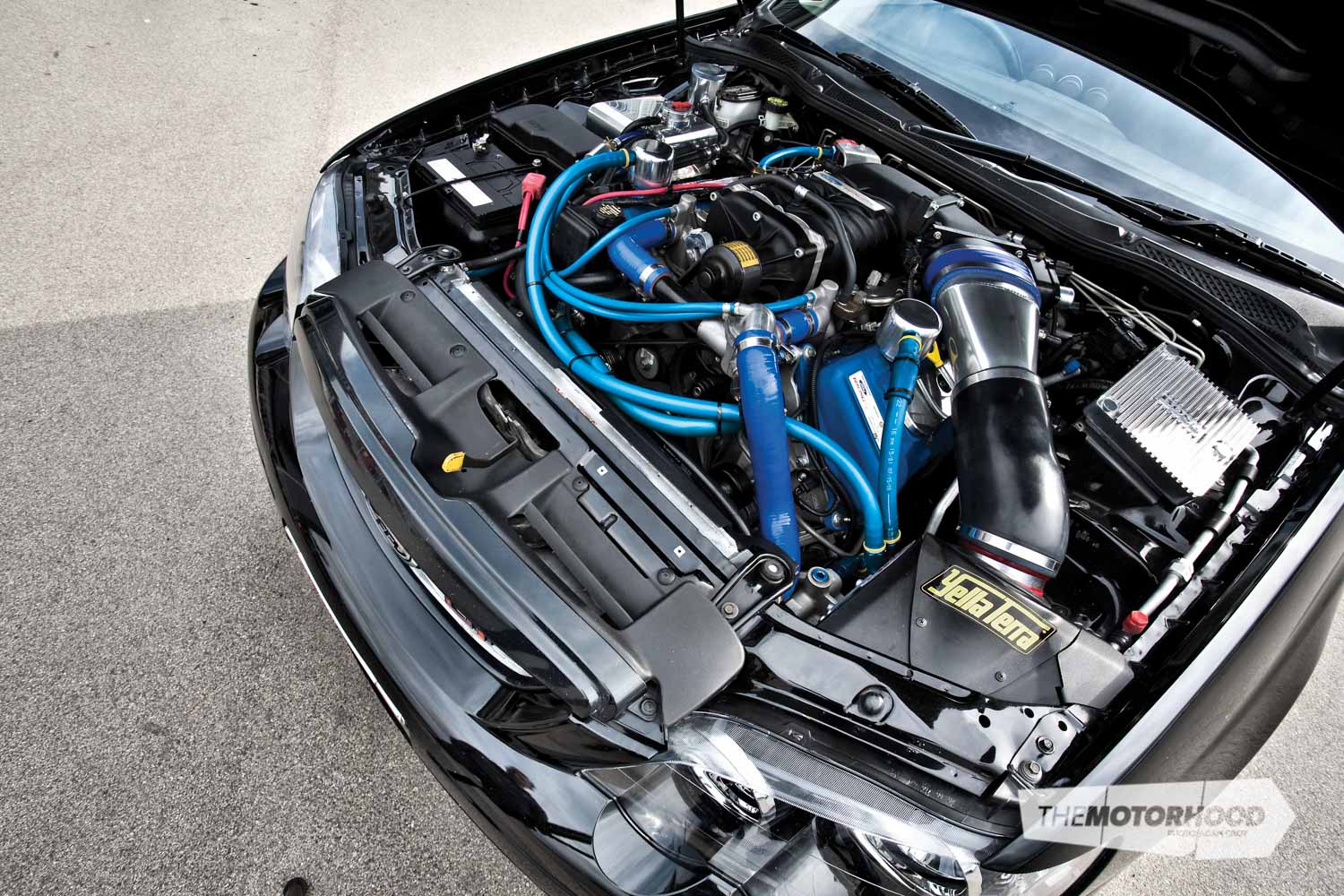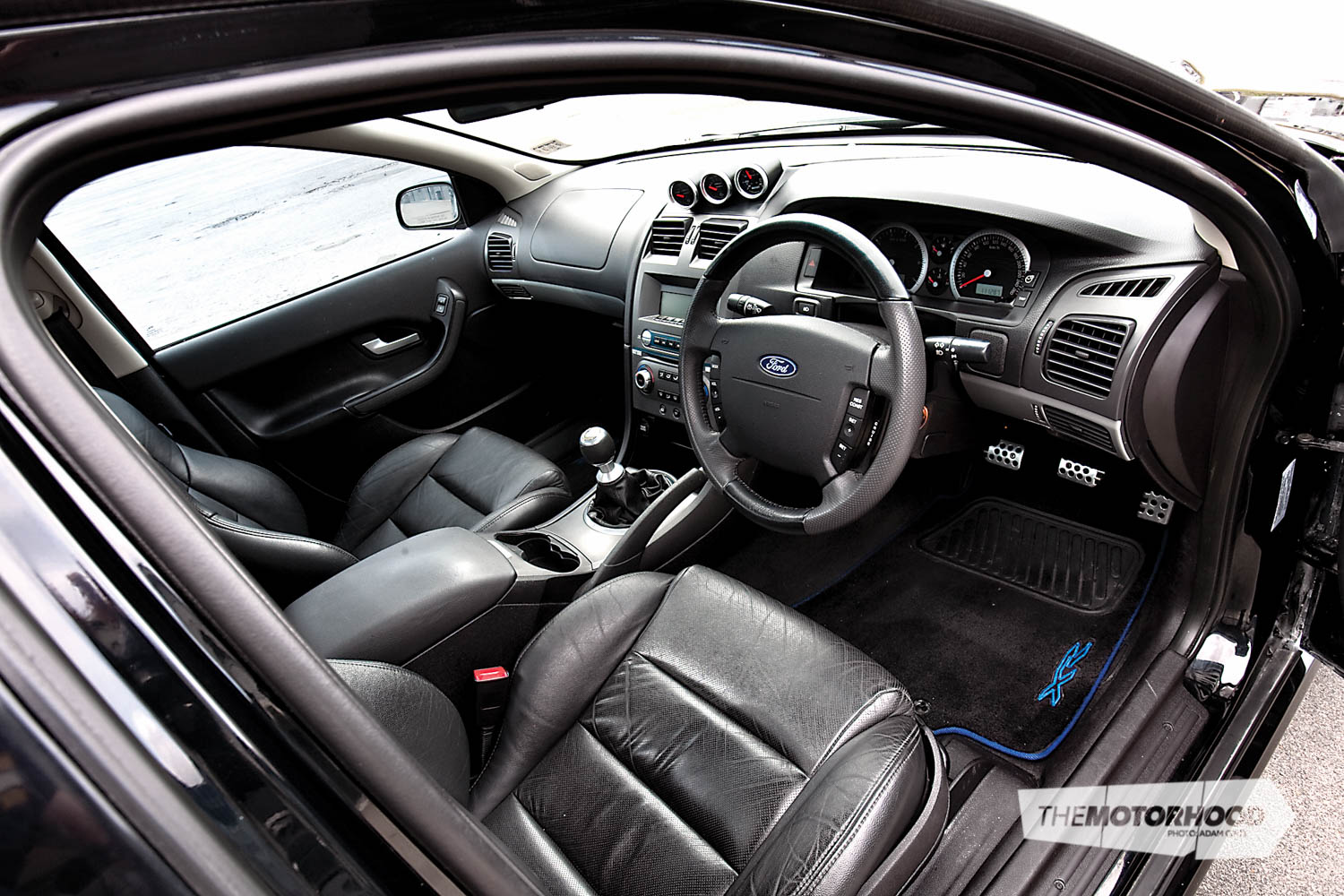data-animation-override>
“After destroying his original engine with too much boost, Scott Allen was left with two choices: scrap the project or build it better. Guess which option he chose”
A muscle car man at heart, Scott Allen has owned a bunch of seriously cool cars in his time, although none quite as cool as his current selection.
The name Boss 302 gets any Mustang owner’s heart pounding, and Scott’s lucky enough to have one. He’s also got the 302’s bigger and far less common brother, the 428 Cobra Jet, a very rare and impressive car that most Ford lovers would kill for. But just to prove he’s not solely a Ford fan, they’re kept company by the Chevrolet equivalent, a ’69 Z28 Camaro.

Obviously, someone with an eye for rare and powerful muscle cars is going to have a passion for going fast, too, and that’s where this story really begins. Back in 2005, Scott was looking for a new daily driver that would allow him to get around the country with his work gear in a bit of comfort. The then brand-new BAII ute fitted the requirements perfectly. However, it wasn’t long after the purchase of the six-speed manual ute that Scott began to tire of the car’s limited performance, and the idea of force-feeding it came to mind.
After a bit of research, Scott decided to add a Vortech supercharger. For the next 30,000km all was well, the stock Boss 5.4 motor seeming to handle the 12lb boost it was being forced to inhale. But it all went quite wrong one day when, after a bit of full-throttle overtaking, the dash lights came on and all that could be seen in the rear view mirror was a wall of smoke.
With the rods hanging out the side of the block, there was not a hope of repairing it. In retrospect, the demise was inevitable, and it left Scott wishing he’d spent the cash up front to build a forged motor that would last the distance.

Stuck with having to buy a new motor, Scott visited Paul at Isaac Performance Vehicles (IPV) in Taupo. After discussing the options and weighing up Scott’s seemingly incurable addiction to boosted cars, the duo came up with the idea of fitting a Ford Racing crate motor. Rather than risk another failure the engine would be hand-built by trained technicians to handle forced induction. Since this motor came complete with a 2.3-litre twin-screw Eaton supercharger, you know the internals aren’t going to let go like those of the previous engine.
When ordering the power plant through his Stateside contacts, Paul ticked the box for the Ford GT heads to be fitted. These are the high-flow heads fitted to the Ford GT supercar, and they’re above and beyond anything else available off-the-shelf for Boss motors.

Although you might expect the engine to be a straight drop-in proposition, that wasn’t the case at all. While the engine mounts are the same, the wiring harness and accessories from the original motor had to be fitted. There’s a bit more than a few simple plugs to be changed in the conversion, with various fabrication work required, but nothing the IPV crew couldn’t take care of in-house.
While installing the motor, IPV ceramic-coated four-into-one headers were fitted and attached to IPV cat replacement pipes and a 304 stainless steel big bore.
With the Boss motor slotting so tightly into the engine bay, the exhausts can’t be seen, so the ceramic coating is more to keep the engine bay cool rather than for aesthetically pleasing reasons. The rest of the motor is a visually impressive piece, though, filling the bay to capacity and leaving no doubt that this is a serious performer.
With the motor sitting in the hole, the excitement levels in both the IPV workshop and the Allen household rose, and everyone involved was eager to see and hear the beast fire into life for the first time. Before this could happen, a fuel system consisting of an in-tank surge pump, high-pressure external pump and rising rate regulator had to be fitted. Following this was the upgraded cooling system that now includes a PWR aluminium radiator and an IPV oil cooler kit with remote mount filter.
With plenty of attention to detail the car was coming together nicely, with the IPV fabricated HPC-coated throttle body inlet and Yella Terra airbox that feeds air to the Whipple oval throttle body the finishing touches.
With an IPV custom-written base supercharger tune in the stock XR8 ECU thanks to an SCT X3 flash module, the car fired into life with a glorious cacophony.

The unmistakable sound resonating from the stainless exhaust combined with the whine of the supercharger upfront is unbeatable, and soon lets anyone nearby know the ute isn’t your standard XR8, despite its subtle looks.
With motivation at an all-time high and an office pool running on what power the combination was good for, the ute was wheeled into IPV’s dyno room and fitted to the dyno. After a few hours of custom mapping the tune along with air/fuel ratio and timing tweaks across the rev range and various simulated driving conditions, the final figures left everyone amazed.
The 703hp and 644ft/lbat the flywheel is a good figure in anyone’s books, and in a ute with little weight over the rear wheels, that power makes for a ride that’s fast to the point that it borders on stupidity. Needless to say Scott loves it, and so do we.
Because the car has the potential to rapidly out-perform its road-holding, the IPV team was once again called upon for its expertise.
Progressive rate front springs were fitted, along with aftermarket rear leaves. Those were matched with custom-valved Bilstein shocks, and the cornering ability of the vehicle has been greatly improved as a result.

Adding to this are the 18×8.5-and 18×9.5-inch Wolf rims wrapped in sticky 245/40R18 Dunlop Sport Maxx rubber up front and rapidly disappearing 275/35R18 items from the same manufacturer on the rear.
Sitting behind the Wolfs are a set of FPV Brembo brake calipers. Up front these clamp 335mm DBA two-piece brake rotors, while on the rear slightly smaller 330mm single piece items have been fitted. While they give it away that the car is modified a little, we doubt anyone would guess what’s under the hood.
Scott has yet to try the car on the drag strip with the new motor combo, but recorded a 12-second quarter mile on a G-tech at 120mph. With acceleration like that, the ute should be good for a low 11-second pass — maybe a high 10 at a pinch — if and when it ever hits the strip. Of course, traction (or lack thereof) will be a problem, but it’s an issue Scott is more than happy to live with. That lack of traction is what makes the ute so much fun to drive, and we can only assume even more fun to own.
Then again, traction or none, as far as NZV8 is aware the ute is the highest-power BA or BF Falcon around. Not bad for a daily driven work hack, eh?
All engine work by Isaac Performance Vehicles
2005 Ford BAII Falcon XR8 ute
- Engine: Ford Racing 5.4-litre TVS supercharged crate engine, Ford GT supercar heads, Whipple billet oval throttle body, IPV/ Yella Terra cold-air induction kit, BMC dual-entry pod filter, IPV fabricated HPC-coated throttle-body inlet, TVS 2.3-litre twin-screw Eaton supercharger, high-flow in-tank anti-surge fuel pump, additional auxiliary fuel pump, adjustable fuel regulator, 72lb fuel injectors, IPV ceramic-coated four-into-one headers, cat replacement pipes, 304 stainless steel big bore package, PWR alloy radiator, IPV engine-oil–cooler kit and remote oil filter, stock ECU, SCT X3 power flash module, IPV custom-mapped dyno tune
- Driveline: Tremec six-speed manual, alloy short shifter kit, IPV billet alloy flywheel and clutch kit, 3.73:1 ratio, carbon-fibre LSD clutch pack, twin driveshaft loops
- Suspension: IPV lowered progressive springs, IPV lowered leaf springs, custom-valved Bilstein shocks
- Brakes: FPV Brembo calipers, DBA 355mm two-piece rotors (front), FPV Brembo calipers, DBA 330mm one-piece rotors (rear), Hawk high-performance brake pads
- Wheels/tyres: 18×8.5-and 18×9.5-inch Wolf rims, 245/40R18 and 275/35R18 Dunlop Sport Maxx tyres
- Exterior: Custom carbon-fibre bonnet
- Interior: Ford leather bucket seats, Momo steering wheel, IPV dash-mounted gauge kit with Auto Meter boost, oil-pressure and oil-temp gauges
- Performance: 456kW (611hp) at the wheels; 703hp and 644ft/lb at engine
Buy a copy of the magazine this article first appeared in below:









